Simultaneous editing of multiple loci based on the endogenous CRISPR-Cas system of Zymomonas mobilis and its application
A Zymomonas and multi-gene technology, applied in the field of genetic engineering, can solve the problems of reduced transformation efficiency, complicated operation procedures, host cell toxicity, etc.
- Summary
- Abstract
- Description
- Claims
- Application Information
AI Technical Summary
Problems solved by technology
Method used
Image
Examples
Embodiment 1
[0038] Example 1 Construction of Zymomonas mobilis Endogenous CRISPR-Cas Genome Editing System
[0039] (1) CRISPR-Cas phylogenetic analysis of the genome encoding of Zymomonas mobilis
[0040] The premise of the present invention is that the research strain needs to encode the CRISPR-Cas system itself and have DNA splicing activity, which requires the host genome to encode the CRISPR cluster and the complete Cas protein system.
[0041] Zymomonas mobilis Z. mobilis 4 is the model strain, for Z. mobilis The ZM4 sequencing data was analyzed, and the results showed that the genome of the strain encoded four CRISPR structural sequences, which were named CRISPR1-CRISPR4 according to their sequence in the genome, see figure 1. CRISPR1 occupies the 113,783-114,170 region of the genome and contains 7 repeat sequences; CRISPR2 occupies the 1,244,355-1,245,866 region and contains 9 repeat sequences; CRISPR3 occupies the 1,598,754-1,599,144 region and contains 7 repeat sequences. ...
Embodiment 2
[0071] Example 2 Application of Zymomonas mobilis-based endogenous CRISPR-Cas system in simultaneous editing of multiple gene loci
[0072] The present invention first selects three different editing sites on the genome to design gRNA, and then designs the corresponding donor DNA. Then, construct a gene editing plasmid, construct an artificial CRISPR cluster on the plasmid for simultaneous expression of the corresponding gRNA, and at the same time, clone the donor DNA into the same editing plasmid. Finally, the editing plasmid was electrotransformed into Zymomonas mobilis cells, and the target strain after accurate editing was screened and identified. The specific operation is as follows.
[0073] (1) Select the knockout target site
[0074] The multi-site gene editing object of the present invention is genome-encoded CRISPR genes 1-4 (CRISPR1-4), wherein CRISPR3 and 4 are located adjacent to each other on the genome, and they are knocked out as an editing target.
[0075] ...
PUM
 Login to View More
Login to View More Abstract
Description
Claims
Application Information
 Login to View More
Login to View More - R&D
- Intellectual Property
- Life Sciences
- Materials
- Tech Scout
- Unparalleled Data Quality
- Higher Quality Content
- 60% Fewer Hallucinations
Browse by: Latest US Patents, China's latest patents, Technical Efficacy Thesaurus, Application Domain, Technology Topic, Popular Technical Reports.
© 2025 PatSnap. All rights reserved.Legal|Privacy policy|Modern Slavery Act Transparency Statement|Sitemap|About US| Contact US: help@patsnap.com



